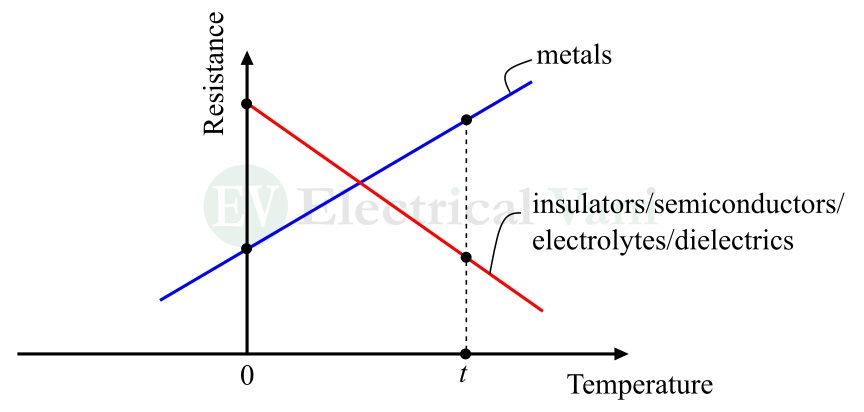In this article, I will explain the effect of temperature on resistance of metals, semiconductors, and insulators. I will also explain why electrical resistance changes with the temperature. As we know, metals, semiconductors, and insulators are materials that form the basis of electrical and electronics engineering. Also, the electrical resistance of materials plays a vital role in selecting an appropriate material for a specific application. Hence, being an electrical or electronics engineer, we must understand the relationship between resistance and temperature for a particular material so we can choose the right material for a particular application in our circuit or device.

Before discussing the effect of temperature on electrical resistance, let us first get an overview of resistance.
What is Electrical Resistance?
The electrical resistance of a material is defined as the measure of opposition offered by the material to the flow of electric current through it.
The electrical resistance of a material is mainly due to an intrinsic property of the material which is called resistivity.
The electrical resistance of a material is denoted by the letter R and is measured in the Ω (Ohms).
Read More: Explore the complete article on the resistance.
Classification of Electrical Materials
Depending on the value of electrical resistance, electrical materials can be classified into the following categories:
- Conductors/Metals
- Semiconductors
- Insulators
- Electrolytes
- Dielectrics
The resistance of these materials is affected by the temperature differently. I have explained the effect of temperature on the resistance of this material in the following sections.
Effect of Temperature on Resistance of Conductors or Metals
Conductors are the electrical materials that offer the least resistance to the flow of electric current through them.
All the metals are the conductors of electric current, hence we use the metals as the synonym for conductors in electrical engineering.
Examples of conductors or metals are silver (best conductor), gold, aluminum, copper, iron, etc.
Resistance of Conductors or Metals:
As the electron theory of matter, electric current in metals or conductors is the directed flow of electrons. Hence, when electrons flow through the material under the influence of an applied electric field, they collide with the atoms of the material. These collisions oppose the movement of electrons through the material and result in electrical resistance.
How does Temperature affect Resistance of Conductors:
The temperature of a conductor significantly affects its resistance.
When the temperature of a conductor increases, the vibrations of the atoms of the material increase. Due to increased vibrations, the movement of electrons becomes more difficult. Consequently, results in higher electrical resistance.
On the other hand, if the temperature of conductors decreases, their resistance also decreases.
Hence, we can conclude that the resistance of electrical conductors or metals is directly proportional to their temperature.
Therefore, the conductors or metals have a positive temperature coefficient of resistance.

Effect of Temperature on Resistance of Insulators
Insulators are electrical materials that have the highest electrical resistance. This is because insulators have almost zero free electrons for the flow of electric current. In the case of insulators, all the electrons are tightly bound in the atoms.
Examples of insulators are wood, rubber, glass, plastic, etc.
Since insulators do not conduct electric current, they are used to design electrical protective devices like line insulators, insulator shoes and gloves, etc.
Resistance of Insulators:
In insulators, the number of free electrons is almost zero. All the electrons are tightly bound to the nucleus of their atoms. At normal temperatures, these electrons cannot break the bonds to become free and conduct electric current.
This is the main reason behind the very high electrical resistance of insulators.
How does Temperature affect Resistance of Insulators:
When the temperature of an insulator is increased, the vibrations of its atoms are also increased. Due to high temperature, few electrons gain enough amount of energy to break the bonds.
At very high temperatures, most electrons in the atoms gain sufficient energy to break the bonds and become free to conduct electric current.
This is how high temperature releases a significant number of free electrons in insulators to conduct electric current.
Therefore, when the temperature of insulators increases, their electrical resistance decreases.
On the other hand, at lower temperatures, the electrical resistance of insulators is very high.
Hence, insulators have a negative temperature coefficient of resistance.
Effect of Temperature on Resistance of Semiconductors
Semiconductors are electrical materials that have an electrical resistance anywhere between the resistance of conductors and insulators.
Also, semiconductors conduct electric current due to positive and negative charge carriers i.e., holes and electrons.
Examples of semiconductors are silicon, germanium, boron, arsenic, etc.
Resistance of Semiconductors:
In semiconductor materials, the resistance is due to a smaller number of free charge carriers, holes and electrons.
At normal temperatures, semiconductors have very high electrical resistance and hence do not conduct the electric current.
This is because, at normal temperatures, the number of free electrons and holes in semiconductors is very low and results in high resistance.
How does Temperature affect Resistance of Semiconductors:
When the temperature of semiconductors is increased, the number of free electrons and holes in the material increases due to thermal excitation.
The greater number of electrons and holes can conduct more current and result in a lower resistance.
Therefore, the resistance of semiconductors decreases with the rise in temperature. Hence, semiconductors also have a negative temperature of resistance.
Effect of Temperature on Resistance of Electrolytes
Electrolytes are materials that give irons to conduct electric current when dissolved in water.
Electrolytes conduct electric current due to the movement of positive and negative ions called cations and anions respectively.
Examples of electrolytes are solutions of sodium, potassium, calcium, phosphate, chloride, etc.
Resistance of Electrolytes:
The resistance of electrolytes is mainly due to the following two reasons:
- A smaller number of positive and negative ions in the solution.
- Low mobility of ions.
How does Temperature affect Resistance of Electrolytes:
Since, in electrolytes, the conduction of electric current is due to the movement of ions. When the temperature increases, the number of ions also increases. Also, the thermal energy increases the kinetic energy of the ions and results in their enhanced mobility. Consequently, the resistance of electrolytes decreases with the rise in temperature.
Hence, electrolytes also have a negative temperature coefficient of resistance.
Effect of Temperature on Resistance of Dielectrics
Dielectrics are electrical materials that act as insulators but they can be polarized by applying an external electric field.
Some common examples of dielectrics are ceramic, mica, glass, vacuum, etc.
Resistance of Dielectrics:
Dielectrics are also insulating materials having no free electrons to carry the electric current. All the electrons present in the atoms of a dielectric are tightly bound to their nucleus. This is the main reason behind the high resistance of dielectric materials at normal temperatures.
How does Temperature affect Resistance of Dielectrics:
The relationship between the temperature and resistance of dielectric material is quite complex and material-specific. But technically, the variation in the resistance of dielectrics with the change in temperature is similar to that of the insulators.
That means, when the temperature of a dielectric is increased, the electrons gain sufficient energy to break the bonds with their atoms and become free to move. This results in a decrease in resistance.
Hence, with the increase in temperature, the resistance of dielectrics decreases. Therefore, dielectrics have a negative temperature coefficient of resistance.
Conclusion
In conclusion, in electrical and electronics engineering, we deal with different kinds of engineering materials such as conductors, insulators, dielectrics, electrolytes, and semiconductors. Each type of material has a different relation with the change in temperature which is explained in this article.
In this article, I have explained the effect of temperature on the resistance of metals, semiconductors, insulators, dielectrics, and electrolytes.
If you have any queries related to this topic. Please let me know in the comment section. I will answer shortly.